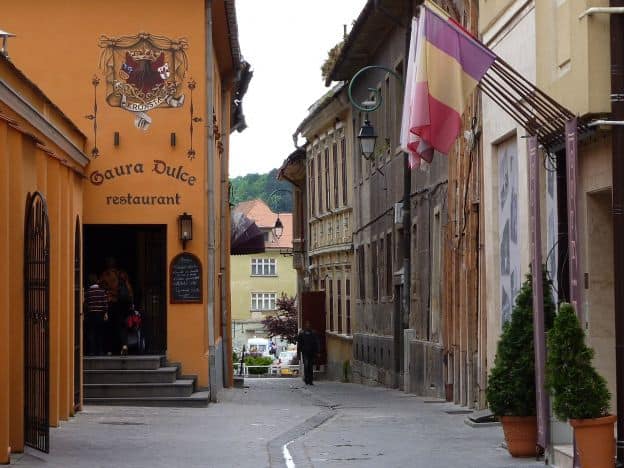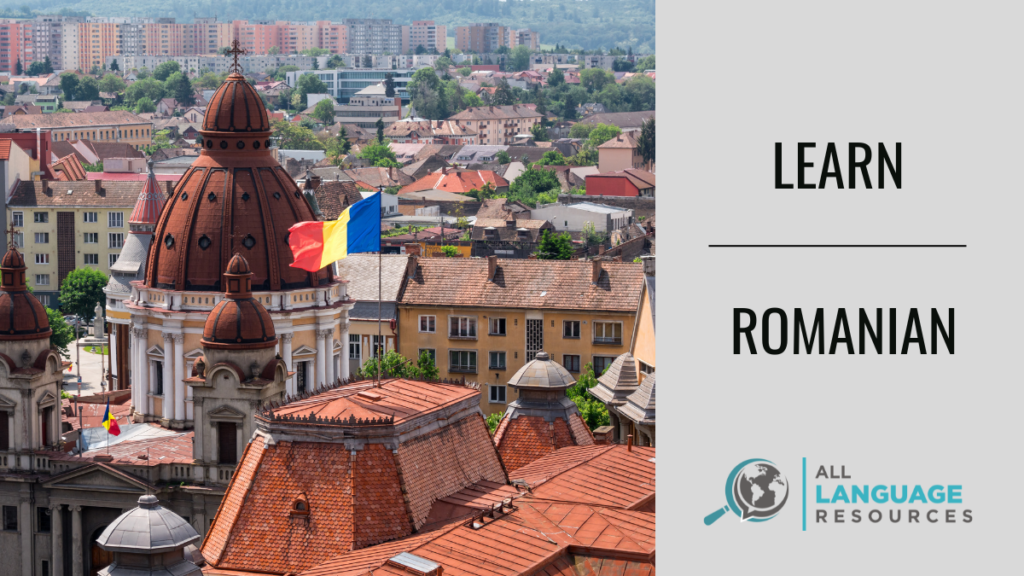When you think of Romance languages, you probably think about French. Or Spanish. Or Italian. Or Portuguese.
Despite the clue in the name of the language, Romanian may not come to mind.
Romanian is spoken as a native language by over 20 million people in Romania and three million more in Moldova. It’s a Romance language in the middle of a primarily Slavic linguistic neighborhood — surrounded by four Slavic Indo-European languages (Bulgarian, Ukrainian, and Serbian) and a Uralic language (Hungarian).
Start learning Romanian alphabet, vocabulary, and grammar. Discover the best resources, study guides, and tips, and create your own study plan.
- About the Romanian Language
- How to Learn Romanian: Hacking Romanian for English Speakers
- What's the Best Way to Learn Romanian?
- What's the Easiest Way to Learn Romanian?
- How Long Does it Take to Learn Romanian?
- How to Learn Romanian Fast
- Your Plan for Learning Romanian
- How to Speak Romanian
- Local Media Resources for Learning Romanian
About four million more people speak it as an auxiliary language. Romanian has speakers all over the world, in places as far-flung as North America, Australia, Israel, and Finland.
Even though Romanian is spoken by nearly thirty million people worldwide, it still sometimes gets confused with similar-sounding but unrelated languages. Romanian is not a form of Romani (an Indo-Aryan language spoken by the traveling Roma people), Romang (an Indonesian language of the Malayo-Polynesian family), or Romansh (a Western Romance language spoken in Switzerland).
About the Romanian Language
Romanian, called Romȃneşte or limba română by its speakers, is a rather interesting Romance language.
If you speak any other Romance language — such as Italian, Spanish, or French — a lot of what you see and hear in Romanian will seem very familiar.
Here are a few Romanian words that are similar to words you’ll find in other Romance languages:
● Tu = you (also used in French, Spanish, and Italian)
● Bine = good (like bene in Italian, bien/bon in French, or bueno in Spanish)
● Mersi = thank you (informal, as in French merci)
● Te = you (reflexive/object pronoun, similar to French and Spanish)
● Meu = my (mio/mia in Italian)
● Ceau = Ciao (pronounced the same as in Italian)
● Eu = I (as in yo in Spanish, or io in Italian)
● Lapte = milk (as in the Italian phrase, caffè latte)

In some ways, Romanian embraces Latin even more than its sister languages. In fact, unlike other contemporary Romance languages, Romanian retains some characteristics of Latin noun declension. Like Latin, Romanian has a neuter gender. Many of the neuter nouns in modern Romanian had also been neuter in Latin. A neuter gender is a feature that has been lost in other Romance languages, such as French, Spanish, and Italian.
Although Romanian is very similar in sound to a lot of other Romance languages, it also has grammatical features in common with other Balkan languages — like Croatian, Bulgarian, and Albanian. For instance, rather than using a separate word for “the,” the definite article becomes a part of the noun.
And Romanian certainly looks like a Balkan language, with its use of the diacritical comma on ț and ș — and its use of ă, î, and â as part of its extended Latin alphabet.
Romanian might even be mistaken for Russian in Transnistria, Moldova, where it’s written in the Cyrillic alphabet. This is a holdover from when part of modern-day Moldova was known officially as the Moldavian Autonomous Soviet Socialist Republic, between 1924 and 1940.

How to Learn Romanian: Hacking Romanian for English Speakers
Romanian, classified by the U.S. Department of State’s Foreign Service Institute as a “Category I” language. This means that it’s somewhat similar to English. It’s considered about as easy for a native English speaker to learn as French, Portuguese, Italian, or Spanish.
The Foreign Service Institute estimates that it would take, on average, between six to seven-and-a-half months of fairly intensive training to become proficient at Romanian. This would entail about five hours of classroom instruction, five days a week.
Now, unless we’re registered for employer-sponsored language training in preparation for an upcoming stint in Romania or Moldova, most of us are not going to be able to dedicate that kind of time to learning the language.
That may not be bad news, though. A recent study by Paul Kelley, et al., shows that people learn and retain more when they study in shorter bursts, rather than long, intensive sessions.
Even though it may take a few months longer, you should still be able to become proficient in Romanian through consistent study — and using the variety of resources we’ll explore in this post.
Let’s take a little closer look at the language, identifying similarities that will help you learn faster, as well as differences that might be challenging.
Helpful Characteristics of Romanian
Romanian has a number of features that make it a little easier to learn for English speakers.
The Romanian Alphabet
The written Romanian alphabet is the same as the Latin one we use in English — with the addition of five special letters (ă, â, î, ș, and ț) that contain diacritical (“accent”) marks.

Although these Romanian letters require a little bit of extra study, it’s not the same as learning a whole new alphabet, script, or set of characters from scratch. Of course, the names of the letters are different than in English, and they are pronounced somewhat differently.
Phonetic Spelling
Spelling and pronunciation are fairly straightforward in Romanian.
There aren’t any pesky “silent letters” like in French or English, although you may find that vowels at the end of words are sometimes inaudible.
Consonants are generally pronounced exactly as you see them written.
One caveat: Like English, Romanian has diphthongs and triphthongs — vowels that, when used together in a word, create a combined sound all their own. LearnRo.com offers a multi-part guide that explains how to pronounce various Romanian vowel combinations. One particularly nice feature of this guide is the audio clips, so you can hear the proper pronunciation of the words that contain them.
Sentence Structure
Romanian follows the same basic “Subject-Verb-Object” sentence structure that we do in English. So, when you see the sentence, Camelia învață engleza, you can safely assume that Camelia is the subject, învață (learns/is learning) is the verb, and engleza (English) is the object.
One difference, though, is that adjectives generally follow nouns in Romanian — just as they do in other Romance languages, such as Spanish and French. Therefore, “an interesting book” in English would be translated as o carte interesantă in Romanian. Interesantă, the adjective for “interesting,” would go after carte (book).
Challenges for English Speakers
Naturally enough, Romanian will present some characteristics that can make it a little tougher to learn.

These are not insurmountable obstacles; you just need to look out for them, and have patience with yourself as you learn.
More Than One “You”
Unlike modern English, Romanian uses a few different pronouns to express the idea of “you.”
Tu is used for informal address of a single person; voi is used to informally address a group of people.
A formal pronoun for “you,” which can be used to respectfully address one or more people, is dumneavoastră.
Grammatical Gender
As mentioned earlier, Romanian has three grammatical genders: masculine, feminine, and neuter.
This can be a stumbling block for English speakers. You can learn patterns to help you recognize word gender.
Noun Cases and Declension
Grammatical cases can cause changes to nouns — much in the same way that verbs are conjugated, or changed, to match the person doing the action, as well as the timeframe or mood.
In English, we have a few grammatical cases, which native speakers don’t think about too often.
When you’re learning Romanian, you’ll need to pay attention not only to the gender of nouns but the changes that nouns undergo when you use them in different contexts.
Yes, No, and Ba
No, a random sheep hasn’t snuck into the Romanian dictionary. Romanian, unlike English, has a third way you can answer a yes/no question — and I don’t mean “maybe.”
If you were answering a yes/no question in Romanian, but in a way that would surprise or contradict the person asking, you would insert the word ba before da (yes) or nu (no).
You can think of this as saying, “Why, yes!” or “No, of course not!”
Rolled Rs
When the letter r is used in Romanian, it needs to be rolled. This is not something that most English speakers are used to, and it can be a bit difficult at first.
If you’ve never rolled your Rs before, there are a variety of techniques you can try.

What’s the Best Way to Learn Romanian?
Immersion is a very effective method for learning Romanian, offering a comprehensive approach to language acquisition. Exposure to Romanian in authentic, real-life settings lets you absorb the nuances, pronunciation, and colloquial expressions naturally. It also provides insights into the cultural context, fostering a deeper understanding of customs and social norms.
Interacting regularly with native speakers enhances listening and speaking abilities, improving pronunciation and fluency through consistent practice. Learning in context becomes a key advantage, as learners observe how words and phrases are utilized in specific situations.
What’s the Easiest Way to Learn Romanian?
Read Romanian Texts
Read books, articles, or news in Romanian. Start with simpler texts and gradually progress to more complex ones as your language skills improve.
Listen to Romanian Music
Repetition in songs reinforces language elements, making it easier for learners to remember words and grammatical structures. The catchy nature of music aids in retention.
Follow Romanian Social Media Channels
Social media is great for language learning. There are Romanian influencers on YouTube, TikTok, and other social media and they are likely in the same niches as influencers you already follow. This is a fun and easy way to pick up vocabulary for your hobbies or profession.
How Long Does it Take to Learn Romanian?
Romanian is ranked by the Foreign Service Institute (FSI) as a Category 1 language, meaning it’s relatively easy for native English speakers to learn. It is rooted in Latin and so shares many ideas with romance languages such as Italian and Sardinian. With that in mind, the FSI suggests it takes around 580 hours of study to become fluent in Romanian.
However, this will vary depending on factors such as your language learning experience and the quality of time you dedicate to studying. Generally, it might take several months of consistent effort to achieve basic proficiency, and longer to become fluent.
How to Learn Romanian Fast
Flashcards for Vocabulary
Create flashcards to memorize new vocabulary. Consistent practice with flashcards can help you expand your Romanian vocabulary quickly.
Watch Romanian Videos with Subtitles
Watch videos in Romanian with English or Romanian subtitles. This can improve your listening skills and help you understand the context of conversations.
Travel to Romania
If possible, spend time in Romania to immerse yourself in the language and culture. Merely being in a country doesn’t guarantee fluency, but if you spend time engaging with Romanian people and authentic materials you will pick up vocabulary and grammar patterns naturally.
Your Plan for Learning Romanian
As you can see, Romanian has aspects that make it somewhat easy for English speakers to learn — as well as characteristics that can seem like roadblocks on your path to learning Romanian.
To learn Romanian well, you’ll need to come up with a plan that meets your goals for learning the language, helps you overcome its inherent challenges, and optimizes the time and learning resources at your disposal.
From your initial desire to learn Romanian, here are a few steps you can take to achieve Romanian proficiency:
1. First of all, you need to look at your motivation for learning Romanian. Do you want to travel to Romania or Moldova and speak the language well as a tourist? Do you want to communicate better with Romanian-speaking family and friends? Are you learning Romanian to take advantage of an opportunity for business or study?
2. Use your motivation to determine your learning goals. If you’re a prospective tourist, you may only need to know enough Romanian to do simple things like order food, purchase train tickets, or find lodgings. If you have personal reasons for learning the language, you’ll want to learn it in a more casual register than someone who uses it for business or formal study. Your learning goals may also include a timeframe, based on your travel or social plans.
3. Depending on how you plan to use the language — primarily for conversation versus reading it in a scholarly setting, for example — you’ll be able to select learning resources that better meet your needs.
4. By determining your learning goals and timeframe, plus looking at the spare time you have available, you can figure out a realistic study plan that guides you to learn a little more Romanian every day.
We’ll be looking at some helpful, varied resources that will introduce you to the Romanian language and help you progress to fluency.

The more ways you expose yourself to Romanian, using multimedia like movies, music, podcasts, games, books, and video, the more the language will become a natural part of your life. The variety will keep your commitment to learning Romanian strong — especially if you look for resources that cater to your personal interests. The more sources for Romanian you incorporate into your daily life, the deeper and more well-rounded your command of the language will become.
Remember to study in short, consistent bursts, learning a little each day. This way, you will be less prone to frustration, and more likely to retain what you learn.

Use tools like a language journal to record your progress and keep your studies on track. Learning any language is a complex undertaking and can seem like slow going, but a language journal can give you more motivation as you use it to clarify your questions, reinforce your retention, and remind yourself how far you’ve come since you learned your first word of Romanian.
As much as possible, try to interact with other Romanian learners and speakers. Language is all about communication. You may be shy and not want to make mistakes in front of others, but stumbling a bit is how you learn to become a better Romanian speaker.
Finally, have fun with the language. Even if you’re learning it for business purposes, Romanian is still a living language that expresses the daily joys, sorrows, humor, and curiosity of its millions of speakers. It’s not a dry, dull rulebook that must be memorized verbatim. Indulge yourself by using the language playfully.
How to Speak Romanian
Take a Course
Consider enrolling in a Romanian language course. This could be an online course, a local language school, or even private lessons with a tutor.
Use Language Apps
Language learning apps, such as Duolingo, Babbel, or Memrise, can be helpful for practicing basic vocabulary and sentence structures.
Learn Basic Grammar
Understanding the basic grammar rules will help you construct sentences correctly. Invest time in learning the fundamentals of Romanian grammar. Practice Speaking
Speaking is crucial for language learning. Find language exchange partners, join language meetups, or use online platforms where you can practice speaking with native speakers.
Local Media Resources for Learning Romanian
In addition to online Romanian courses, mobile apps, and Romanian reference materials, there are numerous other resources that will propel you along your path to Romanian fluency.
Everything from books and music to multimedia resources can play a role in increasing your knowledge of Romanian.
Romanian News Online
Intermediate and advanced learners can ramp up their vocabulary, as well as their knowledge of Romania and Moldova, by following Romanian-language news sites.
Timpul.md is the online home of The Times, a daily periodical from Moldova. Intermediate learners may find it especially helpful to toggle between Romanian and English (or Russian, if preferred) to get an instant translation of any difficult passages. (The language selection is currently located above the masthead in the upper left-hand corner of the site, with flags to easily identify each language.)
Expresul (The Express) is another Moldovan online news site, which primarily covers local Moldovan news.
Based in Bucharest, Radio România Actualități reports primarily on Romanian news, with some international coverage.
Curierul Național is the online home of Bucharest’s National Courier paper. The articles are mostly centered on Bucharest and Romania, with some articles about Europe in the Extern section.
Romanian Music and Radio
A cornucopia of Romanian musical styles may be found on YouTube, as well as streaming service Spotify.

Online Radio Box streams Romanian radio stations from Bucharest, Dolj, and other cities.
Streema is a similar service, which offers dozens of stations in Romania and Romanian-language stations in Moldova.
Many Romanian and Moldovan stations play English-language music, but you’ll still hear announcements and advertisements in Romanian. A few stations, such as Radio Manele and RVE Sibiu, seem to have more Romanian-language music.
Radio România Actualități, which you can stream from Online Radio Box, is a Romanian government-run news radio station. It also broadcasts some music.
For Romanian radio on-the-go, the Radio Online România app is available for Android and iOS devices.
Romanian Television and Movies
Romanian TV packages are not easy to come by, at least not in the United States. Neither Sling TV nor DISH network have a Romanian television package for subscribers.
At this writing, Netflix has a limited number of Romanian-language TV shows and movies. You can get Romanian audio for several films and a few documentaries. Most of the films are for children, though.
Amazon offers a selection of Romanian films and television programs, some of which are available on Prime Video as part of an Amazon Prime membership. International content on Prime Video tends to be captioned in English; it’s not always possible to turn the captions off, or to change their language.
Roku’s Romania TV will let you livestream a handful of channels from Romania. You might also find Romanian-language content on Roku’s Moldova TV. Adding these channels may mean a very small monthly fee — usually, about one U.S. dollar per month. The programming tends to consist of shows from small, community TV stations. There is usually a lot of repeated content, which can actually be helpful for language learners.

Whether you’re packing your bags for București (Bucharest) or Chișinău, or just reaching out to Romanian speakers nearby, you can use these resources and tips to go from absolute beginner to advanced learner.
Noroc și mult succes! (Good luck and much success to you!)


“Voi” is plural for informal ‘You”, not formal singular.